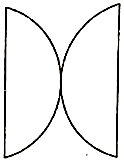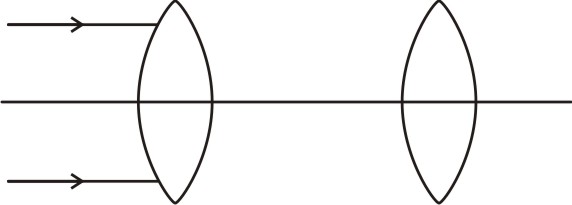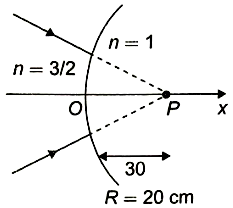A ray of light passes through a plane glass slab of thickness t and refractive index = 1.5. The angle between the incident ray and emergent ray will be:
1. 0
2. 30
3. 45
4. 60

To unlock all the explanations of 14 chapters you need to be enrolled in MasterClass Course.

To unlock all the explanations of 14 chapters you need to be enrolled in MasterClass Course.
A fish looking up through the water sees the outside world contained in a circular horizon. lf the refractive index of water is 4/3 and fish is 12 cm below the surface, the radius of the circle in cm is:
1.
2.
3.
4.

To unlock all the explanations of 14 chapters you need to be enrolled in MasterClass Course.

To unlock all the explanations of 14 chapters you need to be enrolled in MasterClass Course.
The angle of a prism is 60° and the index of refraction of glass with air is 1.5. If the angle of incidence on the first face is and the angle of emergence at the second face is , then the prism produces minimum deviation when:
1.
2.
3.
4.

To unlock all the explanations of 14 chapters you need to be enrolled in MasterClass Course.

To unlock all the explanations of 14 chapters you need to be enrolled in MasterClass Course.
A lens of power +2.0 D is placed in contact with another lens of power -1.0D. The combination will behave like:
1. a converging lens of focal length 100 cm
2. a diverging lens of focal length 100 cm
3. a converging lens of focal length 50 cm
4. a diverging lens of focal length 50 cm

To unlock all the explanations of 14 chapters you need to be enrolled in MasterClass Course.

To unlock all the explanations of 14 chapters you need to be enrolled in MasterClass Course.
A biconvex lens has a focal length of 10 cm. It is cut in half and two pieces are placed as shown. The focal length(in cm) of the final combination is:

1. 10
2. 20
3. 40
4. Not a lens

To unlock all the explanations of 14 chapters you need to be enrolled in MasterClass Course.

To unlock all the explanations of 14 chapters you need to be enrolled in MasterClass Course.
A parallel beam of light is incident on a system of two convex lenses of focal lengths = 20 cm and = 10 cm. What should be the distance between the two lenses so that rays after refraction from both the lenses pass undeviated?

1. 60 cm
2. 30 cm
3. 90 cm
4. 40 cm

To unlock all the explanations of 14 chapters you need to be enrolled in MasterClass Course.

To unlock all the explanations of 14 chapters you need to be enrolled in MasterClass Course.
A pin is placed 10 cm in front of the convex lens of focal length 20 cm and refractive index 1.5. The surface of the lens farther away from the pin is silvered and has a radius of curvature of 22 cm. How far from the lens is the final image formed?
1. 11 cm
2. 12 cm
3. 13 cm
4. 14 cm

To unlock all the explanations of 14 chapters you need to be enrolled in MasterClass Course.

To unlock all the explanations of 14 chapters you need to be enrolled in MasterClass Course.
The image for the converging beam after refraction through the curved surface is formed at:

1. x = 40 cm
2.
3.
4.

To unlock all the explanations of 14 chapters you need to be enrolled in MasterClass Course.

To unlock all the explanations of 14 chapters you need to be enrolled in MasterClass Course.
The dispersion of light in a medium implies that:
1. Lights of different wavelength travel with different speed in the medium
2. Lights of different frequencies travel with different speeds in the medium
3. The refractive index of the medium is different for different wavelength
4. All of the above

To unlock all the explanations of 14 chapters you need to be enrolled in MasterClass Course.

To unlock all the explanations of 14 chapters you need to be enrolled in MasterClass Course.
Which of the following diagrams shows correctly the dispersion of white light by a prism?


To unlock all the explanations of 14 chapters you need to be enrolled in MasterClass Course.

To unlock all the explanations of 14 chapters you need to be enrolled in MasterClass Course.






